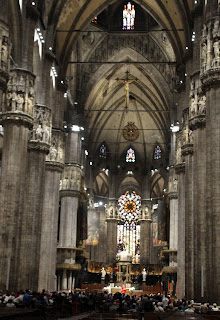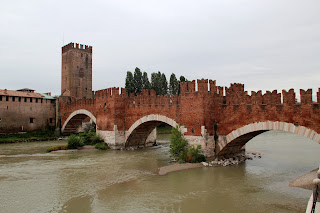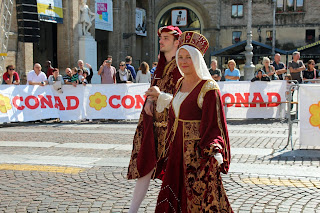When first
planning the trip Milan was primarily the arrival and departure city. The first
draft schedule had us arriving in the city of 1.3 million (5+ million including
the suburbs) the day prior to our departing flight, taking a few sites and then
leaving the next morning. The Milan 2015 Expo and the da Vinci’s Last Supper
changed those plans.
Milan is a modern city with a modern business district with skyscrapers. Like other European cities, Milan has two city centers....the old historic central city and the modern business district many miles away from the old central city.
Given all
that is being done to preserve what remains of this classic artistic work, it
is not easy to get in to see Da Vinci’s work on the wall of the Convent of
Santa Maria della Grazie. Viewings take place in 15 minute blocks with no more
than 25 people per group. Walk-up tickets are hard to secure…such as when a
scheduled person does not arrive on time. Tickets are best secured 4 to 6
months ahead. As we had done so our day was scheduled around our afternoon
viewing time.
The work is
in poor shape due to the techniques and paint da Vinci used, moisture in the
wall from an underground stream and the fluctuations of weather as the mural is
painted on an exterior wall. Over the centuries work has been done to repair
the painting….including special cleanings and repeated touching up of the paint.
Today, after extensive restoration work to remove all the touch up paint layers, we
have only about 45% of the original left, but what remains is still impresses.
The symbolisms, the subtle messages in the position of the bodies, hands, feet
and facial expressions are powerful. The original must have been stunning (the picture of the Last Supper is not mine as taking pictures of it is prohibited). We have a good idea of what the original looked like as Giovanni Rizzoli under the supervision of da Vinci painted on canvas a full scale copy. Rizzoli's copy is on display in London England at the Royal Academy of Arts.
After viewing
the Last Supper we visited the grounds of the Sforza Castle which was on the
way back to our apartment. The castle first built in the 1300s was added onto
the expanded throughout the centuries into a huge fortress. The castle is so
vast that it houses nine different art collections and museums as well as a
rare book library. As it was late in the day we didn’t have sufficient time
before closing to do any of the collections. Visiting the collections and
museums would be left to another day.
On the
second day we headed to the Milan Expo for the day. Arriving as the gates open we
found that long lines were already forming at the pavilions. Long lines from
the outset of the day are inevitable as the pavilions don’t open until an hour after
the gates open. The Milan Expo is designed with the pavilions flanking one main
street. Though we visited several pavilions, as the morning progressed the
lines became longer. By 12:30 we took a break for lunch and had difficulty
finding any place to sit…all the lunch lines were about a half hour long.
After lunch
we looked cueing up for the Italian pavilion but with a 2.5+ hour line we
changed our minds. With other lines becoming well more than hour long, and the
central street a mass of people moving slowly along together, by 2:30 we
decided it was time for us to leave. The Milan Expo was such a disappointment that
we both agree that we are not likely to visit another Expo in the future.
On the way
to the Milan Duomo early Sunday morning we walked around Galleria Vittorio Emanuelle
II. Built in the 1860s and 1870s this covered shopping mall is one of the
oldest malls still operating. With glass vaulted ceilings, decorative stone
work and stone flooring, the Galleria is well worth viewing.
The Duomo
(Cathedral) which dominates that area of the city is too ornate and gaudy for
my taste. To say it is grand and elaborate would be an understatement. The Cathedral is located in an older part of the city and well removed from the modern skyscrapers of the modern business district. The Duomo is
the 5th largest church in the world and took nearly 700 years to
build it (started in 1386 and was completed in 1865). Its stonework is
currently undergoing needed cleaning to restore it back to its glistening white
condition. Its many roof is adorned with
such a multitude of spires that a trip to the roof is now an attraction that
can be accessed for a price. Once on the roof, one has a wonderful unobstructed
view of that area of the city.
As we were
visiting on a Sunday, we elected to take in one of the several worship services
taking place over the course of the morning. While not anywhere close to the
nature of St. Mark’s in Venice, the interior décor and artwork is rich. The
space is expansive with marble floors, high vaulted ceilings and multistory
stone colonnades.
We spent the
end of the day relaxing, walking around our area of the city and having dinner
before returning to our apartment to prepare for our journey home.
While flying
into Milan passing through customs and immigration was efficient, our departure
process was different. We had to do high amount of walking to get from the
train terminal to immigration control, and a long walk from immigration control
the airline’s check-in in, then another long walk to security and then a long
walk to the gate. Our total walk time was about a half hour, excluding the time
waiting in line. Arriving at the airport at least two hours before one’s Milan flight
is definitely advised for Milan, and when you arrive at the aircraft gate be
prepared to find seating for less than a quarter of the passengers.



























































